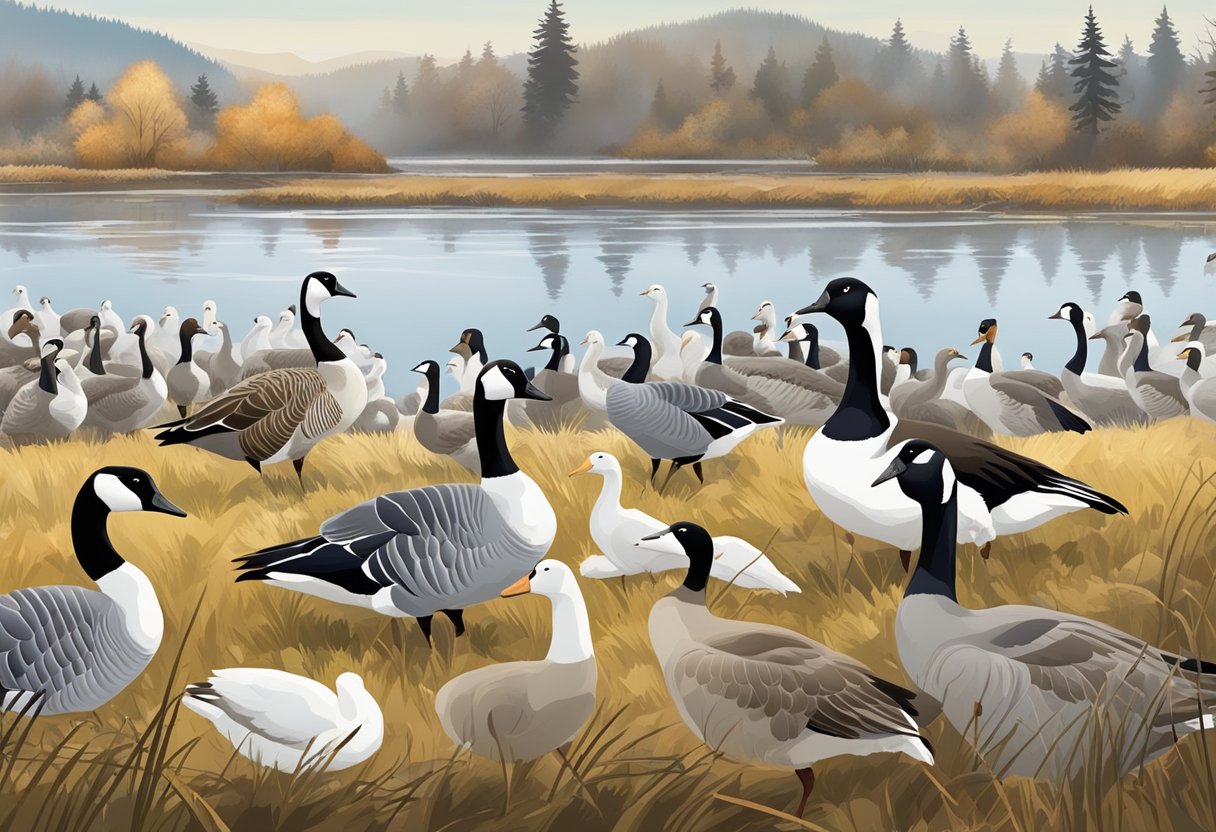Types Of Geese
Geese are fascinating birds that have been domesticated for centuries. They are part of the family Anatidae, which also includes ducks and swans. There are many different types of geese that vary in size, color, and behavior. In this article, we will explore the different types of geese and their unique characteristics.
Species and subspecies of geese are often classified based on their physical characteristics, such as size, color, and feather patterns. There are over 20 species of geese, each with their own unique traits. Some of the most common species of geese include the Canada goose, snow goose, and barnacle goose. These species are further divided into subspecies, such as the lesser snow goose and the cackling goose.
Physical characteristics are an important aspect of identifying different types of geese. Geese are known for their long necks, webbed feet, and distinctive honking calls. They also have a variety of plumage colors, from white and gray to black and brown. Some species of geese have distinctive markings, such as the black head and neck of the Canada goose or the black and white barred feathers of the bar-headed goose. Understanding the physical characteristics of different types of geese is key to identifying them in the wild or in captivity.
Key Takeaways
- There are over 20 species of geese, each with their own unique traits and characteristics.
- Physical characteristics such as size, color, and feather patterns are used to classify different types of geese.
- Understanding the physical characteristics of different types of geese is key to identifying them in the wild or in captivity.
Species and Subspecies

Geese are a diverse group of birds that can be found in many parts of the world. There are several species and subspecies of geese, each with its own unique characteristics and features. In this section, we will take a closer look at some of the most common geese species and subspecies, including the Canada Goose, Snow Goose, Brant Goose, Greater White-Fronted Goose, Greylag Goose, and Emperor Goose.
Canada Goose
The Canada Goose is one of the most common and recognizable geese species in North America. It has several subspecies, including the Lesser Canada Goose and the Giant Canada Goose. Canada Geese are known for their distinctive black heads and necks, white chinstrap, and brownish-gray body. They are found throughout North America, from the Arctic tundra to the southern United States.
Snow Goose
The Snow Goose is a medium-sized goose species that breeds in the Arctic and migrates south to North America during the winter. It has two color morphs: white and blue. The white morph is pure white with black wingtips, while the blue morph is grayish-brown with a white head and neck. Snow Geese are found in large flocks and are known for their distinctive honking calls.
Brant Goose
The Brant Goose is a small goose species that breeds in the Arctic and migrates south to North America, Europe, and Asia during the winter. It has a dark body with a white belly and neck, and a black head and neck. Brant Geese are known for their distinctive honking calls and are often found in large flocks.
Greater White-Fronted Goose
The Greater White-Fronted Goose is a medium-sized goose species that breeds in the Arctic and migrates south to North America during the winter. It has a brownish-gray body with white patches on the face and belly, and a distinctive white band around the base of the bill. Greater White-Fronted Geese are known for their distinctive honking calls and are often found in large flocks.
Greylag Goose
The Greylag Goose is a large goose species that breeds in Europe and Asia and has been introduced to North America. It has a grayish-brown body with a white belly and black tail feathers. Greylag Geese are known for their distinctive honking calls and are often found in large flocks.
Emperor Goose
The Emperor Goose is a small goose species that breeds in the Arctic and is found only in Alaska and Russia. It has a dark body with a white head and neck, and a distinctive orange bill. Emperor Geese are known for their striking plumage and are often found in small flocks.
In conclusion, geese are a diverse group of birds that can be found in many parts of the world. There are several species and subspecies of geese, each with its own unique characteristics and features. Whether you are interested in North American, European, or Asian geese, there is sure to be a species or subspecies that catches your eye.
Physical Characteristics
Geese are known for their unique physical characteristics, which make them easily distinguishable from other waterfowl. The following subsections will discuss the size and shape, plumage and feathers, legs, and beak of geese.
Size and Shape
Geese are generally large birds, with an average body length of 30 to 43 inches and a wingspan of 50 to 60 inches. They have a long neck and a broad, rounded body, which gives them their characteristic shape. Domestic geese, which have been selectively bred for meat production, can be even larger and heavier than their wild counterparts.
Plumage and Feathers
Geese have a variety of plumage colors, including white, gray, black, and brown. Some species, such as the Snow Goose, have distinctive markings on their feathers, while others, like the Canada Goose, have a more uniform coloration. Geese also have a layer of down feathers underneath their outer feathers, which helps keep them warm in cold weather.
Legs and Beak
Geese have strong, sturdy legs and large, webbed feet that are adapted for swimming and walking on land. Their beaks are also unique, with a serrated edge that helps them grip and tear food. The color of their beaks can vary depending on the species, with some geese having bright orange or pink beaks, while others have darker, more muted colors.
Overall, geese have a distinctive appearance that sets them apart from other birds. Their large size, unique shape, and colorful plumage make them a favorite among birdwatchers and nature enthusiasts alike.
Behavior and Ecology
Geese are social birds that often form flocks and mate for life. They exhibit a range of behaviors that are influenced by their environment, including breeding, nesting, feeding, and migration.
Breeding and Nesting
Geese typically breed in the spring and summer months, with females laying up to 12 eggs in a clutch. They build their nests on the ground near water sources, using a variety of materials such as grass, moss, and feathers. Both parents take turns incubating the eggs, which hatch after about a month.
Feeding Habits
Geese are herbivores that primarily feed on a variety of aquatic vegetation such as pondweed and water lilies, as well as grasses and grains. They are also known to consume small animals like insects, worms, and crustaceans. Invasive species such as eelgrass can have a negative impact on geese populations by reducing the availability of their preferred food sources.
Migration and Territoriality
Geese are known for their impressive migration patterns, with some species traveling thousands of miles each year. They often establish territories during the breeding season and can become aggressive towards intruders. Conservation efforts have been implemented to protect geese habitats and control invasive species, which can threaten their food sources and overall population.
Geese in Human Culture
Geese have been an important part of human culture for thousands of years. From their domestication to their economic importance, geese have played a significant role in many aspects of human life. This section will explore the various ways in which geese have impacted human culture.
Domestication and Breeds
Geese were domesticated over 3,000 years ago in Egypt and have since been bred into various breeds for their meat, eggs, and feathers. Some of the most popular breeds include the Chinese goose, African goose, Swan goose, Brecon Buff goose, Co goose, and Emden goose. These breeds have been selectively bred for specific traits, such as size, egg production, and meat quality.
Goose shows have become popular events where breeders showcase their best birds and compete for prizes. The American Poultry Association recognizes several breeds of geese and sets standards for their appearance and characteristics.
Economic Importance
Geese have played an important role in the economy, particularly in the production of foie gras. Foie gras is a luxury food product made from the liver of a goose or duck that has been force-fed to fatten it up. This controversial practice has been banned in some countries due to animal welfare concerns.
Geese are also used for their meat and feathers. In some regions, such as Landes in France, geese are raised specifically for their meat and are an important part of the local cuisine.
Conservation and Research
Geese are also the focus of conservation efforts and research. Captive breeding programs have been established to help preserve endangered species, such as the Hawaiian goose and the Nene goose. Researchers and ornithologists study geese to better understand their behavior, migration patterns, and habitat requirements.
In conclusion, geese have played a significant role in human culture, from their domestication to their economic importance and conservation efforts. Through selective breeding, goose shows, and captive breeding programs, humans have been able to shape and preserve various breeds of geese.
Geographical Distribution
Geese are found all over the world, with different species and subspecies having adapted to a variety of habitats. Below are some of the major geographical regions where geese are found.
North American Populations
North America is home to several species of geese, including the Canada Goose, Snow Goose, and Ross’s Goose. These geese are found throughout the continent, from Alaska to Mexico. Many of these populations migrate seasonally, with some populations traveling thousands of miles each year.
European and Asian Distribution
Europe and Asia are home to several species of geese, including the Greylag Goose, the Bean Goose, and the White-fronted Goose. These geese are found in a variety of habitats, from marshes to subarctic regions. Many of these populations are migratory, traveling long distances each year.
Other Regions
Geese are also found in other regions of the world, including South America, Australia, and Africa. In these regions, native species of geese have adapted to a variety of habitats, from wetlands to grasslands.
Overall, geese are adaptable birds that have managed to thrive in a variety of environments. Whether they are wild geese or domesticated breeds, these birds are an important part of the ecosystem and have played an important role in human history.






